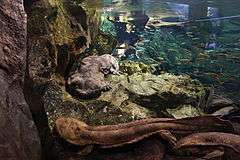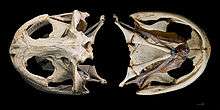Japanese giant salamander
| Japanese giant salamander | |
|---|---|
 | |
| Scientific classification | |
| Kingdom: | Animalia |
| Phylum: | Chordata |
| Class: | Amphibia |
| Order: | Caudata |
| Family: | Cryptobranchidae |
| Genus: | Andrias |
| Species: | A. japonicus |
| Binomial name | |
| Andrias japonicus (Temminck, 1837) | |
| Synonyms | |
|
Megalobatrachus japonicus (Reviewed by Sato 1943)[1] | |
The Japanese giant salamander (Andrias japonicus) is endemic to Japan, where it is known as Ōsanshōuo (オオサンショウウオ/大山椒魚), literally meaning "giant pepper fish". With a length of up to almost 1.5 m (5 ft),[2] it is the second-largest salamander in the world, only being surpassed by the very similar and closely related Chinese giant salamander (A. davidianus).
Behavior


The Japanese giant salamander, being restricted to streams with clear, cool water, is entirely aquatic and nocturnal. Unlike other salamanders, which lose their gills early in their lifecycles, they only breach their heads above the surface to obtain air without venturing out of the water and onto land. Also due to their large size and lack of gills, they are confined to flowing water where oxygen is abundant.[3] When threatened, these salamanders can excrete a strong-smelling, milky substance with an odor resembling Japanese pepper (hence its common Japanese name, giant pepper fish). It has very poor eyesight, and possesses special sensory cells covering its skin, running from head to toe, the lateral line system. These sensory cells' hair-like shapes detect minute vibrations in the environment, and are quite similar to the hair cells of the human inner ear. This feature is essential for its hunting because of its poor eyesight. It feeds mainly on insects, frogs and fish. It has a very slow metabolism and lacks natural competitors. It is a long-lived species, with the captive record being an individual that lived in the Natura Artis Magistra, the Netherlands, for 52 years.[2] In the wild, they may live for nearly 80 years.
History
The Japanese giant salamander was first catalogued by Europeans when the resident physician of Dejima Island in Nagasaki, Philipp Franz von Siebold, captured an individual and shipped it back to Leiden in the Netherlands, in the 1820s. The species was designated as a special natural monument in 1951, and has been protected.[4]
Status
The Japanese giant salamander is threatened by pollution, habitat loss (among other changes, by the silting up of the rivers where it lives), and overcollection. It is considered near threatened by IUCN, and is included on CITES Appendix I.[5] It can be found on the islands of Kyushu, Honshu, and Shikoku in Japan. In the past, they were fished out of rivers and streams as a source of food, but hunting has ceased because of protection acts.
Life cycle
Japanese giant salamanders remain in bodies of water their entire lives. During mating season, sexually mature adults go up stream into the mountains to spawn and lay eggs. The male releases milt over the eggs laid by the female. Larvae emerge from the fertilized eggs, and lose their gills once they metamorphose into adults.
Cultural references

The Japanese giant salamander has been the subject of legend and artwork in Japan, for example, in the ukiyo-e work by Utagawa Kuniyoshi. The well-known Japanese mythological creature known as the kappa may be inspired by the Japanese giant salamander.[6]
See also
References
- ↑ "Amphibian Species of the World - Andrias japonicus (Temminck, 1836)". Research.amnh.org. Retrieved 2010-02-04.
- 1 2 Andrias japonicus - Amphibiaweb
- ↑ The Encyclopedia of Reptiles and Amphibians. Facts on File Inc. 1986. ISBN 0-8160-1359-4.
- ↑ オオサンショウウオ (in Japanese). The Agency for Cultural Affairs. Retrieved 2011-09-24.
- ↑ Japanese giant salamander. ARKive. Retrieved 2008-09-19.
- ↑ "River Monsters" programme 6 Series 3 directed by Duncan Chard, screened in UK on ITV1 14.02.2012 at 19.30
External links
| Wikispecies has information related to: Andrias japonicus |
 Media related to Andrias japonicus at Wikimedia Commons
Media related to Andrias japonicus at Wikimedia Commons- Andrias japonicus at CalPhotos
- Discovery Channel Video On The Giant Salamander
- BBC report
- Video I shot in Minoo, Osaka, Japan of Cryptobranchus japonicus, Giant Japanese Salamander
|
